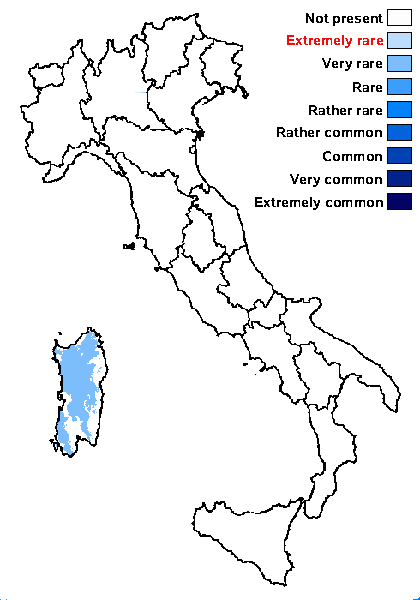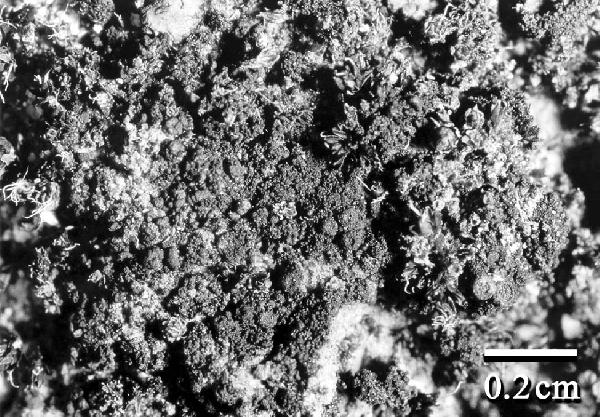Porocyphus coccodes Flot. ex Körb.
Syst. Lich. Germ.: 426, 1855
Synonyms: Collema furfurellum Nyl.; Homopsella aggregatula Nyl.; Porocyphus areolatus (Flot.) Körb.; Porocyphus cataractarum Körb.; Porocyphus coccodes (Flot.) Körb.; Porocyphus furfurellus (Nyl.) Forssell; Porocyphus vivariensis Couderc; Psorotichia furfurella (Nyl.) Boistel; Psorotichia pyrenopsoides (Nyl.) Forssell
Distribution: C - Sar.
Description: Thallus crustose, areolate, black to blackish-olive-green, the areoles angular to irregular in outline, 0.25-1.5(-2.5) mm wide, 0.2–0.5(-1) mm thick, the surface uneven, warted to granulose, usually with vertical, cylindrical, 0.1-0.3(-0.4) mm high, 50-90 µm thick outgrowths and thus appearing coralloid, attached by rhizohyphae originating from a sometimes indistinct, paraplectenchymatous basal layer. Apothecia pycnoascocarps, semi-immersed to sessile, laminal on the areoles or terminal on the vertical outgrowths, 1-3(-5) per areole, up to 0.3(-0.4) mm across, with an initially punctiform, later expanded, dark reddish brown disc and a persistent, entire, 30-40 μm wide thalline margin. Proper exciple deriving from a pycnidial wall, 15-25(-35) µm wide, colourless or yellowish brown in upper part, often visible as a paler ring in wet apothecia; epithecium pale reddish brown; hymenium colourless, (100-)110-150(-200) µm high, I+ blue; paraphyses 1-2 µm thick, indistinctly septate, sparingly branched and anastomosing, the apical cells slightly thickened, up to 3 µm wide. Asci 8-spored, cylindrical, prototunicate, thin-walled, K/I-, without thickened apex or amyloid structures. Ascospores 1-celled, hyaline, broadly ellipsoid to globose, (7.5-)10-14(-18) x (5-)7-12(-15) µm, thin-walled. Pycnidia immersed to slightly projecting, globose to broadly pyriform, 0.075-0.125 mm. Conidia short-cylindrical to broadly ellipsoid, 2-2.5 x 1-1.5 µm. Photobiont cyanobacterial (Calothrix), the cells isolated or arranged in short chains. Spot tests: all negative. Chemistry: without lichen substances.Note: a temperate to southern boreal-montane, probably holarctic lichen found in seepage tracks on steeply inclined surfaces of basic siliceous rocks, e.g. with species of Peltula, more rarely along creeks and rivers.
Growth form: Crustose
Substrata: rocks
Photobiont: cyanobacteria, coccaceous (e.g. Gloeocapsa)
Reproductive strategy: mainly sexual
On otherwise dry surfaces with short periods of water seepage after rain
Commonnes-rarity: (info)
Alpine belt: absent
Subalpine belt: extremely rare
Oromediterranean belt: absent
Montane belt: very rare
Submediterranean belt: absent
Padanian area: absent
Humid submediterranean belt: very rare
Humid mediterranean belt: absent
Dry mediterranean belt: absent

Predictive model

Arizona State University Lichen Herbarium (ASU:Lichens) – Photo by Matthias Schultz CC BY-NC 3.0 - Source: Consortium of Lichen Herbaria (2023) http//:lichenportal.org/portal/index.php. Accessed on December 18.
Growth form: Crustose
Substrata: rocks
Photobiont: cyanobacteria, coccaceous (e.g. Gloeocapsa)
Reproductive strategy: mainly sexual
On otherwise dry surfaces with short periods of water seepage after rain
Commonnes-rarity: (info)
Alpine belt: absent
Subalpine belt: extremely rare
Oromediterranean belt: absent
Montane belt: very rare
Submediterranean belt: absent
Padanian area: absent
Humid submediterranean belt: very rare
Humid mediterranean belt: absent
Dry mediterranean belt: absent

Predictive model

 Index Fungorum
Index Fungorum
 GBIF
GBIF

